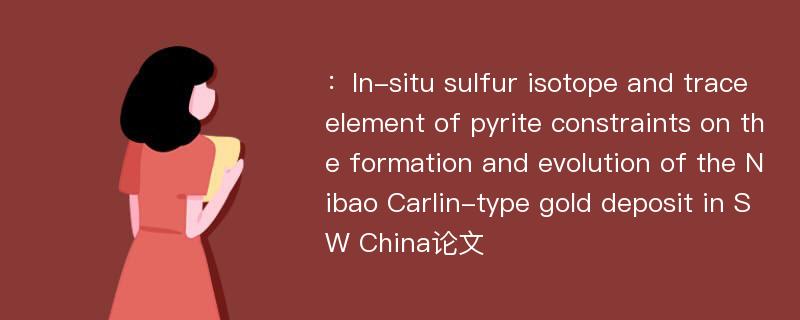
本文主要研究内容
作者(2019)在《In-situ sulfur isotope and trace element of pyrite constraints on the formation and evolution of the Nibao Carlin-type gold deposit in SW China》一文中研究指出:The fault-controlled Nibao Carlin-type gold deposit,together with the strata-bound Shuiyindong deposit,comprise a significant amount of the disseminated gold deposits in southwestern Guizhou Province,China.Five main types and two sub-types of pyrite at the Nibao deposit(Py1a/Py1b,Py2,Py3,Py4,Py5)were distinguished based on detailed mineralogical work.Py1,Py2and Py3 are Au-poor,whereas Py4 and Py5 are Au-rich,corresponding to a sedimentary and hydrothermal origin,respectively.Through systematic in situ analyses of NanoSIMS sulfur isotopes,the framboid pyrite Py1a with negative δ34S values(-53.3 to-14.9%)from the Nibao deposit were found to originate from bacterial sulfate reduction(BSR)processes in an open and sulfate-sufficient condition while the superheavy pyrite Py1b(73.7–114.8%)is probably due to the potential influence of closed-system Rayleigh fractionation or the lack of preservation of deepsea sediments.Data of Py2 and Py3 plot within the area of S isotope compositions from biogenic and abiogenic sulfate reduction.In view of few coeval magmatic rocks in the mining district,the near zero δ34S values of the Au-rich pyrites(Py4 and Py5)may discount the potential involvement of magmatic but metamorphic or sedimentary origin.LA-ICP-MS and TEM work show that Au in ore-related pyrite is present as both nanoparticles and structurally bound.LA-ICP-MS analyses show that the Au-rich pyrite also contains higher As,Cu,Sb,Tl and S than other types of pyrite,which inferred a distal manifestation of deep hydrothermal mineralization systems.
Abstract
The fault-controlled Nibao Carlin-type gold deposit,together with the strata-bound Shuiyindong deposit,comprise a significant amount of the disseminated gold deposits in southwestern Guizhou Province,China.Five main types and two sub-types of pyrite at the Nibao deposit(Py1a/Py1b,Py2,Py3,Py4,Py5)were distinguished based on detailed mineralogical work.Py1,Py2and Py3 are Au-poor,whereas Py4 and Py5 are Au-rich,corresponding to a sedimentary and hydrothermal origin,respectively.Through systematic in situ analyses of NanoSIMS sulfur isotopes,the framboid pyrite Py1a with negative δ34S values(-53.3 to-14.9%)from the Nibao deposit were found to originate from bacterial sulfate reduction(BSR)processes in an open and sulfate-sufficient condition while the superheavy pyrite Py1b(73.7–114.8%)is probably due to the potential influence of closed-system Rayleigh fractionation or the lack of preservation of deepsea sediments.Data of Py2 and Py3 plot within the area of S isotope compositions from biogenic and abiogenic sulfate reduction.In view of few coeval magmatic rocks in the mining district,the near zero δ34S values of the Au-rich pyrites(Py4 and Py5)may discount the potential involvement of magmatic but metamorphic or sedimentary origin.LA-ICP-MS and TEM work show that Au in ore-related pyrite is present as both nanoparticles and structurally bound.LA-ICP-MS analyses show that the Au-rich pyrite also contains higher As,Cu,Sb,Tl and S than other types of pyrite,which inferred a distal manifestation of deep hydrothermal mineralization systems.
论文参考文献
论文详细介绍
论文作者分别是来自Acta Geochimica的,发表于刊物Acta Geochimica2019年04期论文,是一篇关于,Acta Geochimica2019年04期论文的文章。本文可供学术参考使用,各位学者可以免费参考阅读下载,文章观点不代表本站观点,资料来自Acta Geochimica2019年04期论文网站,若本站收录的文献无意侵犯了您的著作版权,请联系我们删除。
